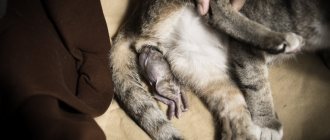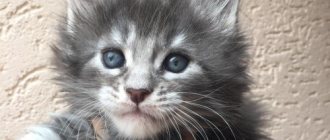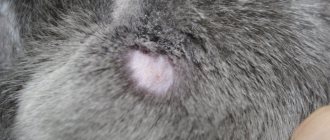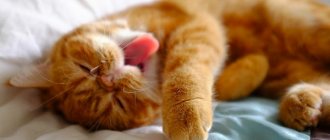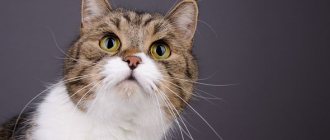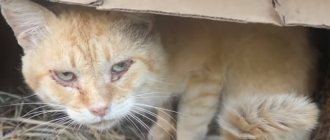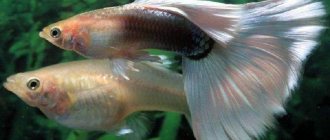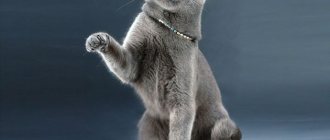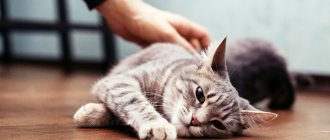Tortoiseshell cats are a very old phenomenon. They became famous and popular in the world many centuries ago. Funny and unusual coloring with spots and streaks distinguishes tortoiseshell cats from their relatives. The bizarre coloring is such that no two identical cats can be found in nature. Perhaps this is why it is believed that a tortoiseshell cat will bring happiness to its owners.
Tortoiseshell color
Characteristics of tortoiseshell color
In short, tortoiseshells, also called “Tortillas” or “Torties,” combine two colors other than white in their color, either closely mixed or arranged in large patches.
The colors are often described as red and black, but instead of the first spots there may be orange, yellow or cream, and instead of charcoal, chocolate, gray, tabby or blue (gray) are possible.
A cat with a striped pattern as one of its colors is sometimes called a torby.
"Tortoiseshell" is commonly seen in multi-colored cats with relatively little or no white markings. Those animals that are primarily snowy with tortoiseshell markings are described as tricolor, tortoiseshell (in the UK) or "calico" (in Canada and the United States).
The "tortoiseshell" phenomenon occurs in many different breeds, as well as outbred domestic cats. This pattern is especially common in Japanese Bobtails, as well as in the Cornish Rex group.
Tortoiseshell cats have colorful coats with patches in varying shades of red and black, and sometimes white. "Tortoiseshell" may also have orange or gold markings, but these are less common.
The size of the spots can vary from small mottled patterns to large colored areas. As a general rule, the lighter the cat, the more continuous the color markers on its skin. Dilution genes can change color, lightening the fur to a mixture of cream and blue, lilac or fawn. The markings on cat fur are usually asymmetrical.
Sometimes there are also striped patterns in black and brown (eumelanistic) and red (pheomelanistic) colors. Such animals are called tortoiseshell tabby, torby or, with large white areas, caliber. Often there is a pattern figuratively called a “split face”, with black on one side and orange on the other, with a dividing line running along the bridge of the animal’s nose. Torti coloration can also be expressed in a dotted pattern called tortoiseshell dot.
“Split face” color
Also read about tabby cat color.
Color-point Persian cats, or Himalayan cats (color-point)
The Color Point Persian cat is a very special cat. In a word, the Siamese color and the Himalayan color are one and the same. Breeders in England, the USA and Europe spent a lot of effort to achieve perfection of the square silhouette, thick coat, mask and paws of the Siamese color. There were many problems with him. The Himalayan cat's nose should be snub-nosed, its ears tiny, its eyes very round and watery as little as possible. The color is indicated only on the face, tail, ears and paws. Against the background of long creamy elegant fur, a dark brown mask sets off clear blue eyes, but not too light.
In America in the 1990s, the Masked Persian is always called the Himalayan, but it is no different from the English or European color point. The CFA, GCCF and FIFe consider this cat to be a variety of the Persian, that is, a product of its evolution.
In one litter, kittens can be born both with an excellent contrast of body color and “points”, and with a darkened body. Litter-brothers (seal-point) Persians living in the same conditions and climate can have completely different colors: one will retain a light body color, the other will become almost black. The exhibition life of color points, compared to other colors, is short, although the standards allow “slight darkening of the body to match the points.” Regarding the complexity of judging, it should be mentioned that, for example, cream- and red-point cats “thrive” for a very long time, in particular, the points on the legs are formed by the year. Tortoise point cats (with tortoiseshell markings) are often uncolored red. Although according to the standard, at least one red spot on each point is quite enough. One of the most common shortcomings in colors is pale eye color.
Himalayan cats require careful grooming, especially before a show. It's not that they like being shaken from head to tail to fluff up their fur, but they generally don't resist. They should be brushed regularly to avoid tangles. It is permissible to pluck the hair on the tips of the ears (this is better than trimming them with scissors) to emphasize the tufts inside the ears and draw attention to the childish roundness of the muzzle.
Beautiful blue eyes water. For eye care, use a special lotion and a cotton handkerchief; cotton swabs are prohibited. The Persian cat causes a lot of trouble, so you need to think carefully before adopting such a kitten.
When choosing a show kitten, consult with a serious specialist; do not buy just anywhere. Color point kittens are born white, with colored spots appearing gradually on the tip of the nose and on the ears. The true color becomes visible at three months, as well as possible defects. In this case, you should again contact an experienced specialist. He alone can say whether our kitten will become just a beloved domestic cat (pet class) or an expensive exhibition exhibit (show class). A top-class cat is no more difficult to raise than any other, except for more careful care of the fur. She eats well, loves to play, run, jump, climb, and excitedly sharpen her claws on the scratching post that you should buy for her.
Black smoky Persian
Mr. Cat recommends: genetics of Tortie color and its varieties
The skins of cats of the "tortoiseshell" and "calico" colors are the result of the interaction of congenital and acquired genetic factors.
The primary coat color gene (B) is responsible for cinnamon, chocolate, brown and other similar shades. It may be masked by the codominant gene for orange (O), which is found on the X chromosome and has two alleles, orange (XO) and non-orange (Xo), producing red pheomelanin and black eumelanin pigments, respectively.
Typically, the designation "X" for a chromosome is taken from context, and alleles are designated only by uppercase "O" for orange or lowercase "o" for non-orange.
The Tortie and Calico cat colors are designated "Oo" to indicate that they are heterozygous for the gene.
The (B) and (O) genes can be further modified by the recessive dilute gene (dd), which softens the colors. For example, orange becomes cream, black becomes gray.
Different terms are used for certain colors, for example, gray is called blue or cyan, orange is also called ginger. Therefore, the tortoise shell color can be chocolate or bluish cream or similar shades based on the alleles for the B and D genes.
The cells of female cats, which like other female mammals have two X chromosomes (XX), undergo the phenomenon of X inactivation, in which one or the other of the X chromosomes is switched off randomly very early in development. The inactivated X is called the Barr body.
Cells in which the chromosome carrying the orange (O) allele is inactivated express an alternative non-orange (o) allele defined by the B gene.
Cells with the non-orange (o) allele inactivated express the orange (O) allele. Pigment genes are expressed in melanocytes, which migrate to the surface of the skin during later development.
In bicolored tortoiseshell cats, melanocytes appear relatively early, and the two cell types become intermixed, producing a characteristic mottled appearance consisting of a close mixture of orange and black cells, with occasional small diffuse patches of these same colors.
Bicolor tortoiseshell cat
In calico cats, a separate spotted gene develops in the coat color gene. It produces white, unpigmented patches by delaying the migration of melanocytes to the surface of the skin. There are a number of alleles of this gene that cause greater or lesser delays.
Calico Cat
The amount of white is artificially divided into mitted, bicolor, harlequin and van, varying from an almost dark shade to almost completely snowy. In extreme cases, the melanocytes do not reach the skin, and the cat is completely white (but not albino).
In intermediate cases, melanocyte migration slows down because pigment cells develop late and have less time to mix with other tones.
Observation of calico cats shows that with a small amount of white in the color, the orange and black spots become more distinct, and with even more of it they are completely distinct. Each patch is a clone of cells derived from one original cell in an early embryo.
Tortoiseshell colors with a small number of snow spots are called “Cake plus white”; if there are a lot of light marks, then the term “calico” is used.
The tortoiseshell Calico color implies a calico cat. The word "Calicos" means "triple fur" in Japanese, and in Dutch the term "lapjeskat" (spotted cat) is used.
Also read the article about whether there are tricolor cats.
The factor that distinguishes "tortoiseshell" from "calico" coloration is the nature of eumelanin and pheomelanin, this is partly dependent on the amount of white due to the influence of the snow spot gene on the overall distribution of melanin.
A cat that has both the orange and non-orange gene, Oo, and a light to almost white marking will be a variegated mixture of red (cream) and black (blue), reminiscent of a tortoiseshell. A cat with Oo alleles with a lot of white will have huge, well-defined patches of red (cream) and black (blue), and this is called "calico."
With intermediate amounts of white, a cat may have a calico pattern, a tortoiseshell pattern, or something in between, depending on other epigenetic factors.
A true tricolor should consist of three colors: white, red (orange, yellow or cream) pheomelanin and black (brownish or gray (blue)) eumelanin.
The tricolor should not be confused with the natural gradations in the striped coat. The shades that are present in the pale tabby stripes are not considered a separate color.
The variations of the tricolor are as follows:
- The basic "turtle shell" pattern has several different colors depending on the eumelanin color (locus B) and dilution (locus D).
- Thorbies display tabby patterns on both colors. Calico cats are also called calibers or tabicos.
Care
Blue Britons require care in several ways.
- It happens that discharge occurs around the eyes, and this occurs in both kittens and adults. For cleaning, use a cotton swab previously soaked in an eye wash solution. If the discharge is purulent in nature, then your pet should definitely be shown to a veterinarian.
- Ears also require care. In normal condition, they should be clean, odorless and uniform in color. To clean your ears, you need to take a cotton swab dipped in a special solution.
- To comb the fur, special brushes are used, which are equipped with either rubber or metal bristles, which should not injure the pet’s skin. Brushing should be taught from a young age so that kittens already understand what is being done to them. The pet must be patient with this care. It is necessary to be especially careful when brushing during the molting period. This procedure will help prevent hair from appearing on furniture, carpets and other places. To collect the hair after the procedure, you can use a special rubber glove or a damp hand. Bathing is not included in the set of mandatory actions.
Blue British cats have excellent immunity. If you care for them properly, they are practically not prone to diseases. If there is the slightest change in your pet’s behavior, you should contact a veterinarian for help, then you can help the animal and avoid serious complications.
To learn about the intricacies of keeping blue British cats, see the following video.
Why are there almost no tortoiseshell cats?
Cats, like male other mammals, have only one X and one Y chromosome (XY). This X chromosome does not undergo X-inactivation, and the color of the coat is determined by which allele is present on it.
Accordingly, the male's coat will either be completely orange or not orange. Very rarely (in approximately one case in three thousand) a male tortoiseshell or “calico” is born.
These animals are more likely to have an extra X chromosome (XXY), a condition known in humans as Klinefelter syndrome, and their cells undergo the same X inactivation process as females.
As in humans, these males are often sterile due to an imbalance in the sex chromosomes.
Some tortoiseshell cats may be genetic chimeras (having both male and female reproductive organs), which is the result of the fusion early in development of two fraternal twin embryos with different color genotypes. These Torti males can only pass on one color to their offspring, but not both, depending on which of the two original embryos their cells came from.
Other male Torties have mosaic genetics, in which the XXY condition occurs after conception and the animal has a mixture of cells with varying numbers of X chromosomes.
All but about one in three thousand rare male calico or tortie cats are sterile due to a chromosomal abnormality, and breeders reject any exceptions for breeding purposes because they are generally of poor physical quality and fertility.
In any case, since the genetic conditions for calico coloration are related to X, the coloration of a fertile male will have no bearing on the coloration of any male offspring (who will receive a Y rather than an X chromosome from their father).
Care and maintenance
Before you get a Briton, it is important to purchase all the accessories necessary for him:
- Sleeping area. Representatives of this breed love to be alone, so it is recommended to buy them a bed or a house, which should be placed in a secluded and quiet place.
- A bowl. Metal utensils with high sides are suitable for food, and ceramic ones for water.
- Tray. Breeders advise using a plastic high box. It is recommended to choose the filler from wood material.
- Comb. It is better to comb a soft, plush fur coat with a massage brush.
- Cloth. The British have a hard time withstanding frost, so it is worth purchasing a warm wardrobe for winter walks.
- Scratching post. It will help wean furry ones from the habit of sharpening their claws on furniture.
If the animal gets used to being in human hands, it will be easier for the owner to care for it.
When you get a British tortoiseshell cat, first of all you should establish a chain of command between the owner and the pet. If the rules of behavior are followed well, it is recommended to reward your pet by treating him with a treat. If the cat misbehaves, you should immediately scold him without using force. Despite the fact that this breed is distinguished by its cleanliness, the kitten needs to be taught to handle hands in order to calmly care for its eyes, ears, and claws, where the tortoiseshell fold cat cannot reach on its own.
Caring for British cats is not difficult, but it is worth remembering and observing some nuances. The main advantage of the breed is its coat. The animal should be combed 1-2 times every 7 days. With a special brush you can remove any loose hair and massage your furry friend. In addition, it is necessary to trim the nails twice a month, even if there is a scratching post.
You should clean your eyes with a damp cotton swab every day to avoid accumulation of discharge.
The ears also need to be paid attention. Use a cotton swab dipped in boiled water to treat the ears.
You will need to examine your mouth every day. If tartar deposits are noticed, dry food should be introduced into the diet, which successfully copes with this problem.
An important aspect of caring for cats is nutrition. Many owners prefer to feed their pets industrial complementary foods. Such food contains all the necessary vitamins and microelements. The main thing is that the tortoiseshell cat, in addition to this food, receives a sufficient amount of liquid. If your pet eats only natural products, then the diet should include raw lean meat, boiled fish and chicken, cereals and vegetables. You should feed your pet 2-3 times a day.
Tortoiseshell cat breeds
Tortoiseshell color is found in many outbred pets and representatives of elite varieties, but most often these are the following cats:
- Arabian Mau;
- British Shorthair;
- Maine Coons;
- Neva Masquerade;
- Siberian;
- Sphinxes;
- Turkish Vans;
- Turkish Angoras;
- Kymriki;
- Kurilian Bobtails;
- Laperms;
- Manx;
- Norwegian forestry;
- Persian;
- Cornish Rex;
- Scottish Folds and Straights;
Fold
- Aegean;
- Exotic;
- Japanese bobtails.
Folklore about tortoiseshell cats
In the folklore of many cultures, tortoiseshell cats are special animals.
Back in Celtic times, cat "turtles" were believed to bring good luck and wealth to homes. Even today, the Irish and Scots believe that stray calico cats are lucky.
In the United States of America, animals with Tortie colors are sometimes called money cats.
The calico cat is also the state symbol of the state of Maryland in the USA. In the late nineteenth century, Eugene Field published a poem for children, "The Duel," also known as "The Calico Dog and the Calico Cat."
Also read signs about tricolor cats.
In Japan, Maneki-neko figures depict calico cats that bring good luck. Japanese sailors often took them with them to protect themselves from misfortune at sea.
Maneki Neko (cat beckoning or inviting cat) is an image of a Japanese Tricolor Bobtail sitting with one paw raised, and is considered a good luck charm among Japanese people around the world, who often keep a statue of this figure in store windows or house windows (most commonly in animals stylized calico color, although gold and black options are also common).
This is due to a legend that tells how a man (usually a priest or a member of the royal family) who owned one of these cats looked up one day and saw his pet calling him. Thinking that the animal might have a message from the gods, he stood up and walked towards it. As soon as he did this, a branch large enough to kill a man fell to where he had been sitting a few minutes ago.
Japanese tricolor bobtails also play an important role in traditional Japanese painting.
In Russian folklore, next to the keeper of the family hearth - the brownie - there is always a tricolor cat.
Owners of tortoiseshell pets often believe that their cats have special personalities and intelligence, but there is little scientific evidence to support this.
However, a 2015 study from the University of California, Davis Veterinary Medicine Teaching Hospital, which surveyed more than 1,200 cat owners, found a link between the "tortoiseshell" pattern and a pet's tendency to be overactive and irritable (hissing, chasing and biting their human companions). According to famed cat expert Jackson Galax, these animals tend to have much more distinct personalities.
Character
Breeders claim that tortoiseshell cats have a unique character. They are characterized by a violent temperament, strong will and a developed sense of possessiveness towards the owner. Tortoiseshell cats are unpredictable in their behavior, irritable and independent.
Such pets are characterized by sociability, which can manifest itself in a variety of ways: cats actively meow, hiss or purr loudly.
Also, “turtles” are called playful pets. Running after a toy will not be enough for them. They will ambush you, hunt your feet, and throw objects off tables and shelves.


